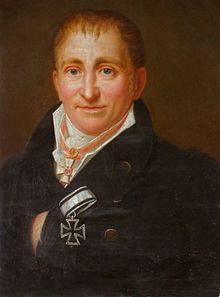Iron cross on a white ribbon
The Iron Cross on the White Ribbon (also Iron Cross on the White-Black Ribbon or Iron Cross for non-combatants ) was a Prussian war award for non-combatants as a variant of the Iron Cross, 2nd class . It was awarded in the Wars of Liberation , the Franco-German War and the First World War . It is named after the white band with a black border.
history
Like the Iron Cross on the black (or black and white) ribbon, the Iron Cross on the white ribbon was created by the Prussian King Friedrich Wilhelm III. Donated on March 10, 1813 in Breslau for the course of the Wars of Liberation in three classes, the Iron Cross II. and I. Class and the Grand Cross :
"2. Both classes have the same black cross made of cast iron in silver, the front without inscription, the reverse side to the top Our signature (FW) with the crown, in the middle three oak leaves and at the bottom the year 1813 and both classes are on a black ribbon with white edging, if the merit has been earned in a fight with the enemy, and on a white ribbon with black edging, if this is not the case, worn in the buttonhole; In addition to this decoration, the first class has a cross of black ribbon with white border on the left breast; and the great cross, once again as large as that of the other two classes, is worn on the black ribbon with white edging around the neck. "
The first class could only be acquired if one had already been awarded the second class. The Iron Cross First Class was only rarely awarded to non-combatants: Of the 374 winners of the Iron Cross on the White Ribbon from 1813, only Wilhelm von Humboldt and Karl August von Hardenberg received the First Class award. Since the Grand Cross according to the foundation charter of 1813 "could only be awarded to the respective commanding officer for a decisive battle won [...], the removal of an important fortress, or for the permanent defense of a fortress", it was not awarded to non-combatants.
Among the 374 bearers of the Iron Cross 2nd class on the white ribbon from 1813 are 36 officers, eight ministers, 23 upper presidents, presidents and vice-presidents , seven diplomats, 97 other civil officials, 56 officials of the military administration and eleven merchants. The comparatively very small number of only 70 doctors compared to the later wars is also due to the fact that 189 doctors received the Iron Cross on the black ribbon at the same time.
During World War I there were around 13,000 awards of the Iron Cross on the white ribbon (out of over 5 million awards on the black ribbon). Since the award was often given to people from the armaments industry or logistics, especially during the First World War , they were given the pejorative name "Schieberkreuz".
When the Iron Cross was re-established in 1939, the version for non-combatants was omitted and the ribbon for the combatants became red. Instead of the Iron Cross on a white ribbon, the War Merit Cross was an independent award.
Carrying method
The way of wearing did not differ from that of the Iron Cross II. Class on the black (or black and white) ribbon: The cross was carried entirely on the ribbon. The second class of uniform jackets was worn in the second buttonhole, but since the middle of the 19th century for practical reasons only in full size on the day of the award or on special occasions. Instead, the ribbon could be sewn to the fabric of the uniform jacket at the point of the second buttonhole. The versions of the Iron Cross on the black and white ribbon only differed in terms of the color of the ribbon.
For the first class of the Iron Cross, which was always worn in its original form as a plug-in cross on the left breast, there was only one version for both combatants and non-combatants. The Grand Cross worn on the collar was never awarded to non-combatants.
Towards the end of the 19th century, large and small medal clasps were worn, in which usually only the ribbon was worn on a brass or sheet metal carrier. After 1914, a repeat clasp was introduced for people who already owned an Iron Cross from the Franco-German War, which was also to be worn on the Iron Cross on the white ribbon above the original cross.
See also
literature
- Werner Otto Hütte: The history of the Iron Cross and its significance for the Prussian and German labeling system from 1813 to the present. Bonn 1967, (Bonn, Rheinische Friedrich-Wilhelms-Universität, dissertation, 1967).
- Theodor von Troschke : The iron cross. In: Yearbooks for the German Army and Navy. Volume 1, 1871, ZDB -ID 140029-0 , pp. 1-29 .
Web links
Individual evidence
- ↑ a b Certificate on the Foundation of the Iron Cross (1813), quoted from: Theodor Freiherr von Troschke: Das Eiserne Kreuz. In: Yearbooks for the German Army and Navy. Volume 1, 1871, pp. 1–29, here p. 9 ff.
- ^ Theodor Freiherr von Troschke: The Iron Cross . In: Yearbooks for the German Army and Navy. Volume 1, 1871, pp. 1-29, here p. 26 f.
- ↑ Frank Wernitz : The Iron Cross. 1813-1870-1914. History and meaning of an award (= catalogs of the Bavarian Army Museum Ingolstadt. Volume 11, 1). Verlag Militaria, Vienna 2013, ISBN 978-3-902526-58-8 , p. 402.
